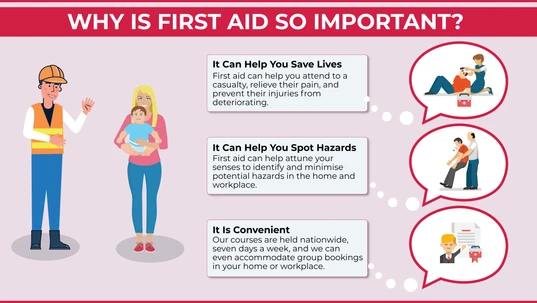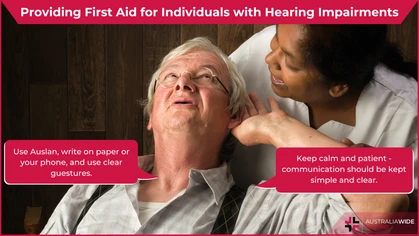What is first aid?

First Aid Training

First aid makes a significant contribution to an ill or injured person’s recovery.
The primary objective of first aid is to preserve life. First aid training focuses on providing immediate care to sick or injured patients until full medical help is available. In the time it takes for more advanced care to arrive, first aid aims to prevent medical conditions from deteriorating, help relieve pain, and provide reassurance.What is the meaning of first aid?
First aid is defined as immediate medical assistance given to an ill or injured person, including interventions such as CPR (cardiopulmonary resuscitation), or complete treatment of minor conditions, while waiting for an ambulance. First aid doesn’t necessarily require particular equipment or prior knowledge. An untrained person could improvise with available materials. More often, basic first aid training is involved, sometimes including training in the use of an AED (automated external defibrillator). There are many situations that require first aid and regulations, under the auspices of Safe Work Australia, that specify a minimum level of first aid.The importance of first aid
The importance of first aid is recognised all over the world and its capacity to make a difference cannot be overstated. To have a competent first aid practitioner present is reassuring to the casualty, as well as to concerned people at the scene. This first aider is the person most likely to take action and manage an emergency. First aid makes a significant contribution to an ill or injured person’s recovery and, in an overwhelming number of cases, has been the difference between life and death.
The Chain of Survival
The 3 Ps of First Aid
The 3 Ps of first aid represent the priorities in first aid treatment:1 Preserve Life
The first aider’s number one responsibility is to preserve life. This means assessing the emergency scene for dangers to self, as well as to bystanders and, of course, to the casualty. The caution for potential danger is the first step in the DRSABCD strategy. You can download a Basic Life Support chart for this DRSABCD strategy. After determining whether the victim is responsive and calling 000 for emergency medical intervention, first aiders would check the person’s airway and breathing. CPR (cardiopulmonary resuscitation) would follow in quick succession. You’ll find plenty of information on CPR, as well as downloads, in our Resource library.2 Prevent Deterioration
This is all about keeping the patient’s condition stable so it does not worsen in the time spent waiting for medical professionals to arrive. To do this, the first responder would provide first aid treatment and reassurance. Further injury would be guarded against and the casualty would be positioned safely and comfortably.3 Promote Recovery
The first responder, in providing first aid treatment, would aim to relieve pain and encourage confidence in the patient. These are important steps in helping the recovery process. These 3 Ps help prioritise a first responder’s actions and play an important role in emergency treatment for victims.Why learn first aid?
First aid training imparts confidence to step up and take action when an emergency occurs. Responding promptly with effective first aid can save a life or prevent a person suffering permanent disability. Minimising risk is invaluable. And prevention is better than cure. First aid knowledge attunes your senses to be alert to, and to identify, potential hazards, both in the home and in the workplace. This allows you, as a first aider, to determine the appropriate steps to minimise danger, including assessing safe emergency responses should they be needed.
When is first aid needed?
First aid certification is a condition of employment in many lines of work. When it comes to threats to our health, the workplace looms large — second only to our homes. For example, where workers are in proximity to a health threat posed by high-powered machinery, there’s a justifiable need for qualified first aiders. Trained first aid personnel are also critical for businesses or community operations that service public gatherings. This includes education centres, transport services, shopping malls, community swimming facilities, sport and fitness complexes, and more. Despite its pivotal role in emergencies, first aid and its considerable benefits, are not the domain of medical professionals. Completing an accredited first aid training is not difficult. It can be done at your convenience, with an online first aid course followed by hands-on training and assessment. Your first aid certificate will give your job application a boost. It’s a requirement in many Australian workplaces. More importantly, should the unexpected happen, your first aid training will have you prepared. Find an accredited first course where you can get your first aid certificate in one day.What’s involved in first aid certification?
After successfully completing a first aid course, you will earn Statement of Attainments — whether for Provide CPR, Provide First Aid, or Provide First Aid in an education and care setting. HLTAID011 Provide first aid is by far, the most popular first aid course in Australia and the minimum requirement for workplace compliance.How long does a first aid certificate last?
First aid certificates do not have expiry dates. Safe Work Australia does recommend renewing them for some important reasons. Procedures change from time to time and compliance with guidelines for CPR, such as those from the Australian Resuscitation Council (ARC), is a serious consideration. More importantly, there's no time for doubt and hesitation when first aid skills are called upon. To keep knowledge and skills from fading, first aid refresher courses are recommended. For these reasons, Safe Work Australia has determined first aid certificate validity as follows: HLATID009 Provide cardiopulmonary resuscitation — 1 year from the date of course completion HLTAID010 Provide basic emergency life support — 3 years from the date of course completion HLTAID011 Provide First Aid — 3 years from the date of course completion HLTAID012 Provide First Aid in an education and care setting — 3 years from the date of course completionFirst aid refresher courses
First aid refresher courses are no different to the standard first aid courses, with one exception — the certificate holder will likely breeze through the online first aid course. And the hands-on training and assessment will also cover familiar territory. Noteworthy for those refreshing their certification will be the details that have changed since the previous certification. As an example, CPR has changed pre and post-COVID, with rescue breaths now being recommended only for those with appropriate PPE (Personal Protective Equipment).How to learn first aid
Learning first aid is widely available and, by no means, expensive. You can learn CPR from a registered training organisation for the price of a kilogram of coffee beans. There are first aid training centres all over Australia and, it’s also possible to have a trainer come to you so you and a group of friends or colleagues can enjoy group first aid training. Australia Wide First Aid offers Instant Price Beat a comparison tool that automatically presents you with a price at least 10% cheaper than any competitor’s price.Other First Aid Resources
Learn more about first aid in the following articles:
Originally published at
https://www.australiawidefirstaid.com.au/resources/what-is-first-aid
as part of the Australia Wide First Aid Articles Library









